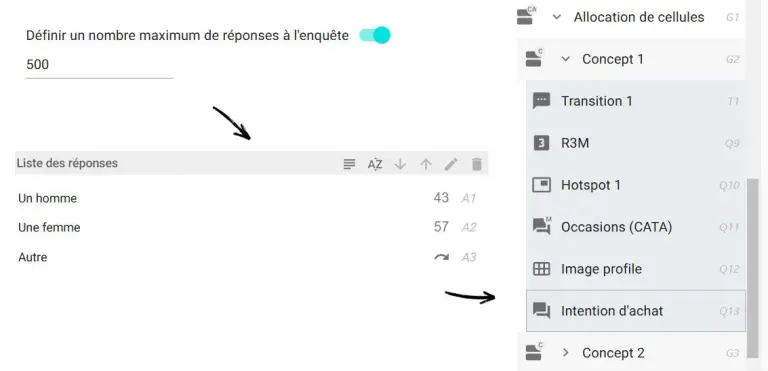In marketing and market research, obtaining reliable, usable results is crucial to the success of any project.
The R3m Score platform stands out for its ability to simplify survey creation while meeting complex needs.
Among its advanced features, cell matching plays a key role in optimizing product and concept testing.
This feature enables the creation of balanced groups of testers, guaranteeing accurate and representative results.
What is cell matching?
Cell matching is a technique used to divide respondents into homogeneous groups based on specific characteristics such as age, gender or socio-professional category.
This method ensures that each concept or product variant is evaluated by people with similar profiles, enabling results to be compared fairly and reliably.
How does R3m score cell matching work?
1 – Define a maximum number of respondents :
The first step is to define a maximum number of respondents in the form parameters. This controls the sample size and ensures that quotas are respected.
2 – Add quotas to profile questions :
To ensure a diverse and representative sample, you can add quotas to the profile questions. For example, you can specify that 57% of respondents must be women and 43% men. This feature ensures that tester groups accurately reflect the target population.
3 – Create a “cell allocation” block:
A “cell allocation” block is then created to automatically allocate respondents according to their characteristics. This block ensures that groups are homogeneous and balanced, which is essential for reliable results.
4 – Add concepts to be tested :
Once the respondents have been allocated, the concepts to be tested are added to the form. Each concept is evaluated by a specific group of respondents, enabling an accurate and fair comparison between the different variants.
Benefits of cell matching
Cell matching in our online survey tool and data analysis tool offers our customers multiple benefits for their surveys and customer feedback.
Reliable test results
By dividing respondents into homogeneous groups, cell matching delivers more reliable and representative results. This is particularly important for product and concept testing, where perceptions and preferences can vary considerably according to demographic characteristics.
Save design time
R3m Score’s cell matching functionality simplifies the process of creating balanced groups. Thanks to automation, users can save valuable time and concentrate on analyzing results rather than managing quotas.
Flexible tester groups
The platform offers great flexibility in defining quotas and group characteristics. This allows users to tailor tester groups to the specific needs of their study.
Comparative analysis made easy
Cell matching facilitates the comparison of results between different groups. By ensuring that groups are homogeneous, users can more easily identify differences and similarities in respondents’ perceptions and preferences.
Conclusion on R3m Score cell matching
Cell matching in R3m Score is a powerful feature that enables users to create balanced, representative groups of testers.
By guaranteeing reliable results and simplifying the process of creating groups, this feature is a valuable asset for marketing research and market research professionals.
Whether you’re testing a new product or evaluating a concept, cell matching on R3m Score helps you obtain accurate, actionable insights to guide your strategic decisions.
By integrating this functionality into your projects, you can not only improve the quality of your data, but also optimize the efficiency of your studies, which is essential in a competitive environment where every decision counts.
This innovative feature enables you to structure your product tests in such a way as to guarantee unbiased, usable results, providing you with a solid basis for informed strategic decisions.
